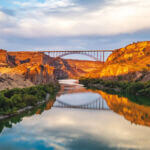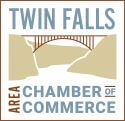Clear, sunny, and access to some of the country’s most impressive landscapes.
Averages
- Twin Falls, Idaho gets 10 inches of rain, on average, per year. The US average is 38 inches of rain per year.
- Twin Falls averages 18 inches of snow per year. The US average is 28 inches of snow per year.
- On average, there are 210 sunny days per year in Twin Falls. The US average is 205 sunny days.
- Twin Falls gets some kind of precipitation, on average, 79 days per year. Precipitation is rain, snow, sleet, or hail that falls to the ground. In order for precipitation to be counted you have to get at least .01 inches on the ground to measure.
Weather Highlights
Comfort Index
- Summer High: the July high is around 89 degrees
- Winter Low: the January low is 20
- Rain: averages 10 inches of rain a year
- Snow: averages 18 inches of snow a year
The annual Comfort Index for Twin Falls is 7.2 (10=best), which means it is one of the most pleasant places in Idaho.
7.2 / 10
June, September and May are the most pleasant months in Twin Falls, while December and January are the least comfortable months.
Credit to www.bestplaces.net
Geography
Twin Falls is home to stunning geography. The impressive, deep Snake River Canyon forms the boundary line between Twin Falls and Jerome counties, and houses three waterfalls within its depths. The most famous, Shoshone Falls, is higher than Niagara. It reaches its peak in spring, after snowmelt swells the river and before the water is diverted to sustain the area’s thriving agriculture. The Snake River provides easy access to outdoor recreation such as fishing, rafting, canoeing, and stand-up paddleboarding.
Twin Falls is within driving distance of the South Hills, City of Rocks, Thousand Springs Scenic Byway, and many other incredible places that beg for exploration.






Become a Member of the Twin Falls Chamber
We're here to help you THRIVE. Become a member of the largest business organization in Southern Idaho, increase your visibility and credibility as a business, and join us today!
Get on board and see the difference!
